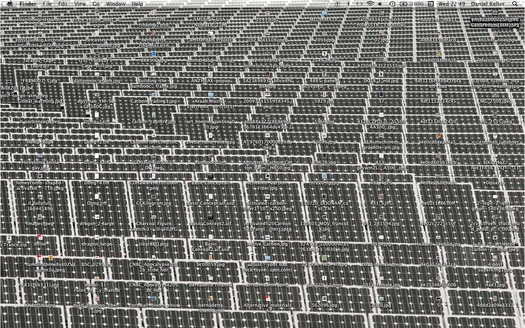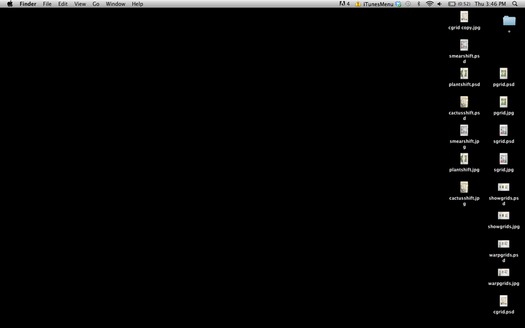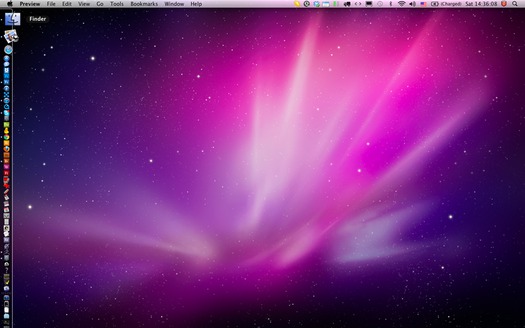So: Nothing against these efforts, or people who love them. But in the non-abstract, this practice of scrutinizing the work spaces of various creators has never done much for me. I remember peering at a room where Faulkner strung together words that have affected me greatly, and feeling precisely nothing as a result. This attitude may inform my reaction to documentation of a different form of work place. But it's a form that I think is worth consideration. Because if you think about the space where creative work actually gets done, and what writers and designers and quite a few artists are really looking at all day, the relevant framework is probably not a room, or a window. It’s probably a screen.

Daniel Keller's desktop, from Desktop Views.
Rhizome’s Jason Huff addressed this recently with a piece comparing two projects that offer a window, as it were, on “15 years of desktop aesthetics.” For a recent effort called Desktop Views, Adam Cruces rounded up images of the computer desktops of 51 artists.
Some (like Jon Rafman) are artists I was familiar with, others I’m not. But as I clicked around, I realized this didn’t make any difference to my interest in what I was seeing. In fact, I suspect that it allowed me to look at many of these images as images, rather than as little virtual tourist attractions concerning someone specific.

Aaron Graham's desktop, from Desktop Views.
Huff’s piece explains that Desktop Views references “Alexei Shulgin’s legendary Desktop Is project, created 15 years earlier in 1997, at the dawn of ‘net.art,’” and it makes worthwhile observations about broader aesthetic changes in screen aesthetics since that time.
He also notes that The Guardian has more recently run a series collecting images of various writers’ desktops, accompanied by interviews. This, turns out, left me cold, even when it involved writers I admire. (“Tom McCarthy explains how technology is woven into his creative life.” Ho hum.) I guess that's no surprise. I'm basically skeptical about revelations gleaned from peeking at a creator’s place, physical or virtual. (Metafilter recently pointed out a feature on Apartment Therapy with the irritating headline, “Literary Style: 15 Writers’ Bedrooms,” that underscores how silly this line of thought can get. As if it weren’t meaningless enough to peer at writers’ bedrooms — wow, so maybe Truman Capote had sex there? Or didn’t? — our assumed curiosity is rationalized by the vauous invocation of “style.” Screw the art, and for that matter screw the screwing: Maybe there are some actionable home décor takeaways here!)
What these visual objects made me think about isn’t the singular writer, artist, designer. Instead I ended up thinking about the way a desktop's look is shaped: a result of decisions that involve productivity (organized or messy?) and aesthetics (custom backdrop or default?) or both (is the custom backdrop expressive, or a waste of time that could be spent doing something more important?).

Parker Ito's desktop, from Desktop Views.
The variety of the results surprised me — particularly given the considerable constraints involved. (The rooms are all shaped the same; many of the objects within them (icons, that is) share visual similarities; etc.) As I thought it over, I remembered that as a category of work space, this is one that's hardly unique to the subset of people I've been calling "creators," but is also inhabited by customer service reps and logistics managers, software engineers and bond traders.
Imagine some collection of desktop images that weren't singularlized, but anonymyzed. Instead of serving as clues or suggestions of indivduality, they'd become objects of speculation and projection. Instead of pretending to seek insight about a particular person, we could peer at this space like a stranger's room, and only wonder: Who works here?

Timur Si-Qin's desktop, from Desktop Views.


Comments [4]
Whether one is a neat freak or has an unbearably messy workspace informs me of a certain thought process. For example, about a year ago I got sick of having icons randomly placed all over my desktop and sop decided to create a wallpaper that had columns for different purposes (eg. "Print", "Organise", "Current Projects", etc) in an attempt to help me better organise my information. I tend to do that a lot. I like order, I like systems, but that's just me. And it's something you will note from the very first time my screen boots up.
Great post!
04.10.12
02:00
I design in peace and quiet with little distraction and a blank screen as my mind often struggles with logical order. I doubt anybody looking in from the outside would be able to analyse or gain insight to my inner world from my desktop.
04.10.12
04:32
I think the spaces where a creative person sets up the computer screen is more important than the screen itself. At least it is for me. I've got a clutter free Macbook Pro desktop but all around me are fun little bits of inspiration to fuel my design work.
04.12.12
11:39
04.12.12
06:07